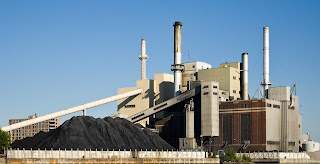 |
| Coal Fired Power Plant |
The combustion of a fossil fuel to generate electricity can be either: 1) in a steam generating unit (also referred to simply as a “boiler”) to feed a steam turbine that, in turn, spins an electric generator: or 2) in a combustion turbine or a reciprocating internal combustion engine that directly drives the generator. Some modern power plants use a “combined cycle” electric power generation process, in which a gaseous or liquid fuel is burned in a combustion turbine that both drives electrical generators and provides heat to produce steam in a heat recovery steam generator (HRSG). The steam produced by the HRSG is then fed to a steam turbine that drives a second electric generator. The combination of using the energy released by burning a fuel to drive both a combustion turbine generator set and a stream turbine generator significantly increases the overall efficiency of the electric power generation process.
Coal is the most abundant fossil fuel in the United States and is predominately used for electric power generation. Historically, electric utilities have burned solid coal in steam generating units. However, coal can also be first gasified and then burned as a gaseous fuel. The integration of coal gasification technologies with the combined cycle electric generation process is called an integrated gasification combined cycle (IGCC) system or a “coal gasification facility”. For the remainder of this document, the term “electric generating unit” or “EGU” is used to mean a solid fuel-fired steam generating unit that serves a generator that produces electricity for sale to the electric grid.
